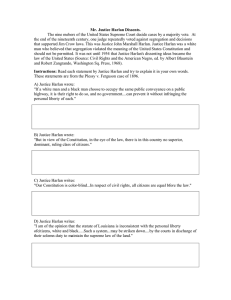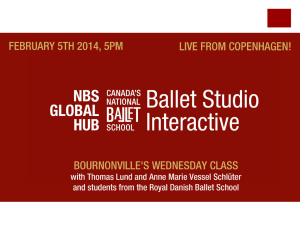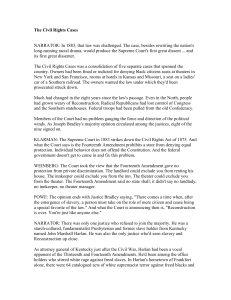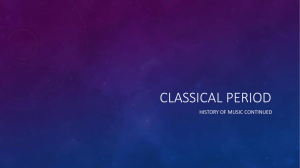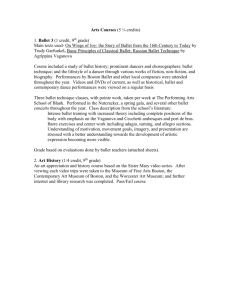Humanities Syllabus - Harlan Independent Schools
advertisement
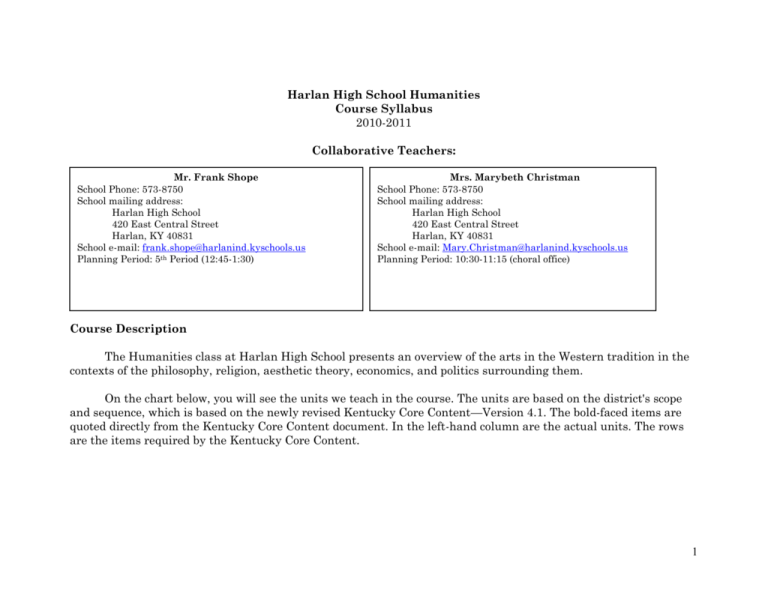
Harlan High School Humanities Course Syllabus 2010-2011 Collaborative Teachers: Mr. Frank Shope School Phone: 573-8750 School mailing address: Harlan High School 420 East Central Street Harlan, KY 40831 School e-mail: frank.shope@harlanind.kyschools.us Planning Period: 5th Period (12:45-1:30) Mrs. Marybeth Christman School Phone: 573-8750 School mailing address: Harlan High School 420 East Central Street Harlan, KY 40831 School e-mail: Mary.Christman@harlanind.kyschools.us Planning Period: 10:30-11:15 (choral office) Course Description The Humanities class at Harlan High School presents an overview of the arts in the Western tradition in the contexts of the philosophy, religion, aesthetic theory, economics, and politics surrounding them. On the chart below, you will see the units we teach in the course. The units are based on the district's scope and sequence, which is based on the newly revised Kentucky Core Content—Version 4.1. The bold-faced items are quoted directly from the Kentucky Core Content document. In the left-hand column are the actual units. The rows are the items required by the Kentucky Core Content. 1 Major Movements/Time Periods/Cultures Renaissance 1400-1600 Reconciles Christian faith and reason. Promotes “rebirth" of the classical ideal. Allows new freedom of thought. MUSIC AH-HS-2.1.1 European counterpoint polyphony Palestrina rise of instrumental and secular music DANCE AH-HS-2.2.1 European court dances Baroque 1580-1700 Rejects the limits of previous styles. Restores the power of the monarchy/ church: excess, ornamentation, contrasts, tensions, energy. (1600-1750) European fugue Bach Handel oratorio European development of ballet Neo-Classicism/ “Classical” 1720-1827 Style in music. Reacts to the excesses of monarchy and ornamentation of the Baroque. Returns to order, reason and structural clarity. “Classical” style of music (1750-1820) European Haydn and Mozart— true classical style; Beethoven— transition from classical to romantic DRAMA AH-HS-2.3.1 European commedia dell'arte Shakespeare and Elizabethan Theatre VISUAL ARTS AH-HS-2.4.1 European Leonardo da Vinci— painting; Michelangelo— sculpture, painting, architecture—built on the innovative architectural techniques of Ancient Greece and Rome (e.g., the arch, vault, dome, principles of stress and counter stress, atrium-style houses, etc.) European Rembrandt—Dutch Baroque, use of chiaroscuro (a bold contrast of light and dark); Caravaggio—Italian Baroque painter, painted harsh realities, used chiaroscuro European satire European Jacques-Louis David— distinctive Neo-Classical style associated with French revolution 2 Romanticism 1760-1870 Revolts against neoclassical order/reason. Returns to nature/imagination: freedom, emotion, sentimentality, spontaneity; interest in the exotic, patriotic, primitive and supernatural. Realism 1820-1920 Seeks the truth. Finds beauty in the commonplace. Focuses on the Industrial Revolution and the conditions of working class (1825-1900) European Tchaikovsky— influence on ballet; Wagner—influence on opera Impressionism and Post-Impressionism 1850-1920 Shows the effects of light and atmospheric conditions. Spontaneously European Debussy Ravel—symbolism in music European golden age of ballet European melodrama American folk and social dance, e.g., square dance, swing, foxtrot European Henrik Ibsen George Bernard Shaw American American playwrights’ role with realism in theatre (Tennessee Williams, Arthur Miller) (English III) American Jefferson—neoclassical architecture with Ancient Greek and Roman architectural influences, reflects ideas of newly independent United States European John Constable— British landscapes; Francisco Goya— Spanish Court painter examined violence, greed, and foolishness of society European Gustav Courbet— attention on the common man; Edouard Manet— focused on industrial age city and people, bridged the gap between realism and impressionism European Claude Monet— tried to capture light as a moment of time; Vincent van Gogh— used bright colors 3 captures a moment of time. Expresses reality in different ways. Modern and Contemporary 1900-Present Breaks with or redefines the conventions of the past. Uses experimental techniques. Shows the diversity of society and the blending of cultures. European Stravinsky— influence on Russian ballet American multiple cultural influences, blending of cultures and styles: Gershwin—jazz in classical musical forms; Copland—integrated national American idioms into his music; Ellington—the sophistication of American jazz styles; Latin and Caribbean influences in American music— musical styles and idioms integrated into the American mainstream European Balanchine Baryshnikov Fokine—the revitalization and 20th century prominence of Russian ballet American Alvin Ailey— acclaimed African American choreographer incorporation of traditional African roots; African-American themes; Martha Graham— abandoning traditional steps of ballet, portrayed characters in woman’s viewpoint American impact of technology on drama/theatre the development of American musical theatre and line to express emotion; Mary Cassatt— domestic social scenes of women and children; August Rodin— sculptor who used impressionistic style in his work European Salvador Dali— surrealism; Pablo Picasso— multiple style periods including cubism American Andy Warhol— popularized middle class culture; Georgia O’Keefe— large scale abstraction of natural form; Frank Lloyd Wright— American architecture; Dorothea Lange— photography of the Depression era; Jacob Lawrence— reflects the African American experience 4 Japanese Culture Middle Eastern and Asian history and characteristics of Kabuki theatre Temple architecture; characteristics of temples Islamic— e.g. Dome of the Rock; geometric patterns for decorations such as arabesques, minaret tower to call Muslims to prayer; Hindu— e.g. Pampapati Temple— temple city complex with towers Buddhist— e.g. Liurong Temple/ pagoda or called a stupa in India, part of a temple city complex Unique visual arts in Asian Cultures Japanese printmaking; Chinese and Japanese ink and brush paintings; calligraphy 5 Objective It is our objective to explore the humanities not just to acquire facts about past eras, but to try to understand how a culture's questions, answers, and values are represented through their arts. Hopefully, this procedure will enable students to trace the development and changes of the problems that plague us so sorely in our own time. Equipped with knowledge of the great answers found in the past that still shape the way we live today, each individual can work to develop an informed set of values and a freedom to be the person he or she would like to be. Text The text for the Humanities class is The Creative Impulse: An Introduction to the Arts (seventh edition) by Dennis J. Sporre. The text has a companion website at http://wps.prenhall.com/hss_sporre_creative_7 Features of this site include online quizzes, which include instant scoring and coaching plus critical thinking and writing activities. We strongly suggest you make use of this website to aid in comprehension and preparation for quizzes and exams. In addition to the text, you will be given a copy of a disk that contains each of the music selections you are responsible for being able to recognize and analyze. This disk is the property of the school and must be taken care of and returned to the teacher in good condition. Grading Policy Homework, in-class assignments, projects, and tests will be counted individually toward a total number of accumulated points. To obtain a student's grade, the number of points earned will be divided by the total number of possible points. Late Assignments According to the student handbook, students have one day per excused absence to make up any work that has been missed. (This includes tests, quizzes, and all assignments.) It is the responsibility of the student to ask for the makeup work. Any assignment that is otherwise late will be accepted; however, one letter grade will be deducted for each day the assignment is late. After a failing grade has been earned, the assignment will not be accepted. Required Materials Students are required to bring the following materials to class on a daily basis: three-ring binder notebook; The Creative Impulse (text for class); writing utensils; and additional assigned works. Humanities is a class based on participation. If the student misses a class, he very often misses information that cannot be read in a text of fully comprehended by copying someone else's notes; therefore, attendance is extremely important. Those students who are habitually absent will have a difficult time passing the class. 6

